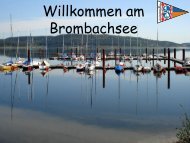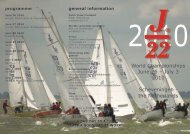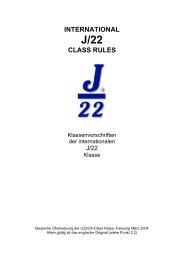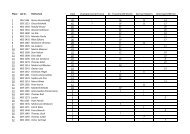international j/22 class rules - J/22 International Class Association
international j/22 class rules - J/22 International Class Association
international j/22 class rules - J/22 International Class Association
Create successful ePaper yourself
Turn your PDF publications into a flip-book with our unique Google optimized e-Paper software.
3.1.4 Minimum Boat Weight. The dry weight of the boat as raced, including one set of sheets only, shall be not less than857kgs. The dry weight shall include: rudder and tiller assembly, mast, boom spinnaker pole, and all running andstanding rigging and may also include the following optional equipment: bow and stern pulpits, stanchions andlifelines, running lights (without battery), compass, permanently installed spinnaker launch bags and an outboardmotor bracket. Items to be excluded when weighing are: sails, battens, paddle, life jackets, hand pump, anchor withchain and warp, mooring lines, fenders, lifting slings, tool kit, first aid kit and personal effects. Corrector weights mustconsist of lead or equivalent material permanently positioned on or forward of the main bulkhead and on or aft of theaft (seat) bulkhead divided in two equal portions. Removal of boat weight and optional equipment included at time ofmeasurement is strictly prohibited.3.2 Hull3.2.1 The standard location and design of winches, jib sheet tracks, chainplates and handrails shall not be altered.3.2.2 Reshaping of the hull profile or contours is prohibited.3.2.3 The minimum molded radius of the corner intersecting the hull and the transom is 2 mm.3.3 Keel3.3.1 The keel shall be of molded lead to the building specifications and cast in a mold supplied by J Boats, Inc.3.3.2 The external dimensions and configuration of the keel shall comply with the table of offsets contained in official PlanC. The keel may be overcoated in any base liquid or paste protective material or fiberglass and faired; provided thatthe fairing does not change the design shape of the keel and that the keel still meets all <strong>class</strong> measurementrequirements.3.3.3 The distance measured from the junction of the transom and the hull at the centerline to: a). The trailing edge of keelat MPA shall not be more than 2908.3mm nor less than 2883mm. b). The trailing edge of the keel at MPC shall not bemore than 3029mm nor less than 3003mm.3.3.4 The maximum depth of the keel as measured from MPA to the bottom of the keel shall not be more than 720.7mmnor less than 708mm.3.3.5 The distance from MPA to MPB shall not be more than 974.7mm nor less than 955.7mm.3.3.6 The distance from MPC to MPD shall not be more than 616mm nor less than 590.6mm.3.3.7 The leading and trailing edge between Sections 1 and 4, shall be straight within a tolerance of + or -3mm. BetweenSections 1 and 4, the surface of the keel shall be fair in every plane.3.3.8 Location of keel measurement point MPB from transom: The distance from transom corner to MPA when added tothe distance between MPA and MPB shall not exceed 3871mm.3.3.9 Location of keel measurement point MPD from transom: The distance from transom corner to MPC when added tothe distance between MPC and MPD shall not exceed 3633mm.3.4 Rudder and Tiller3.4.1 The external dimensions and configurations of the rudder shall comply with the official rudder drawing and table ofoffsets contained in official Plan D. The rudder may be overcoated in any base liquid or paste protective material andfaired, provided it complies with minimum dimensions in official Plan D.3.4.2 The weight of the rudder, including two permanently-attached gudgeons, but excluding the pins, tiller, tillerextension, and all other fittings, shall not be less than 10.88kg.3.4.3 The tiller shall be made of wood. Tiller extensions of any material may be fitted.3.4.4 The leading edge of the rudder shall be parallel within a tolerance of + or - 3mm to an extension of the verticalstraight line down the aft side of the transom.3.5 Spars<strong>International</strong> J/<strong>22</strong> <strong>Class</strong> <strong>Association</strong> Effective Date: March 1, 2013 Published Date: December 15, 2012 Previous issues: March 1, 2010 Page 3
4.10.6 The spinnaker shall be made of nylon except that spinnakers manufactured before June 15, 1992, may be made ofpolyester.4.11 Royalty Paid Labels. Only sails carrying an IJ<strong>22</strong>CA Royalty Paid label sewn onto the starboard side of the sail near itstack or near a spinnaker clew shall be used when racing. Royalty labels shall not be transferred from one sail toanother. Labels are available from the IJ<strong>22</strong>CA Office, 12900 Lake Ave., #2001, Lakewood, Ohio 44107, USA.5. OPTIONAL EQUIPMENTThe following are permitted while racing:5.1 Lifelines, bow pulpit and sternrail to meet owner requirements, Race Committee or government regulations.5.2 Two genoa tracks and affixed cars with blocks attached.5.3 Outboard motor bracket, engine, fuel and extinguishers.5.4 One mechanical masthead wind indicator with or without light.5.5 Navigation lights.5.6 Spare wooden tiller and tiller extension of any material. All tiller brackets must be factory made products. Noalterations are to be made.5.7 Spare spinnaker pole.5.8 Substitution of standard winches with winches having a power ratio not exceeding 8.5:1 and not exceeding 67mm indiameter in the same location. A permanent wedge of up to 25mm in height may be fixed under each winch.5.9 Electronic devices to measure speed and distance and to indicate water depth.5.10 A two-way radio and antenna.5.11 Additional lockers, shelves, bunks, and galley items to personalize interior accommodations as long as such items arefor cosmetic and comfort and do not structurally alter the boat in any way.5.12 Safety equipment and devices to owner's requirements.5.13 Location and design of deck blocks, fairleads, cleats, for spinnaker sheets, topping lift, twings, foreguy and allhalyards.5.14 Leading of the jib sheet through a bullet block attached to the jib clew or through the clew cringle, to double thepurchase, port and starboard.5.16 Installation of fairleads, blocks, and/or cleats, port and starboard, to lead jib sheets aft to the helmsman’s location forsingle-handed sailing convenience.5.17 Two hiking straps, port and starboard, attached at one end (a) on the traveler inboard of cockpit seats or on thevertical wall of the cockpit well within 75mm of the intersection of the traveler bar with the cockpit seat and at theother end (b) to a through bolted padeye in the center of the aft vertical face of the cockpit well within 50mm of thecockpit floor. These straps shall not permit the heel of the helmsman's foot to be outboard of the vertical wall of thecockpit footwell.5.18 Location or design of compass(es) installed.5.19 Interior lighting devices, batteries and switch panel. Batteries must be securely fixed in place.5.20 Carrying aboard a storm trysail of not more than 4m square in area or a genoa provided that they shall not be usedwhen racing.<strong>International</strong> J/<strong>22</strong> <strong>Class</strong> <strong>Association</strong> Effective Date: March 1, 2013 Published Date: December 15, 2012 Previous issues: March 1, 2010 Page 7
5.21 Fixing on the bow a batten or similar device to prevent the spinnaker guy from dropping over the bow. This deviceshall not increase the overall length of the boat by more than 200mm.5.<strong>22</strong> Leading the kicking strap (vang), outhaul, main and jib cunningham control lines to both sides of the boat.5.23 Alternate backstay and traveler control lead(s) and cleat(s).5.24 An extender with a maximum length of 152mm and of no mechanical advantage to connect the 8-part boom vangsystem to the bale on the base of the mast for easier release when under high load.5.25 Additional drilled holes in jib tracks due to variation in sail construction and design.5.26 Removal of the factory tack horn to permit replacement with one snap shackle or shackle. Shackle must be attachedto the factory installed stem fitting.5.27 A fixed-position, mainsheet cleat attached to traveler bar. The traveler bar may be raised for reinforcement purposeswith any material not to exceed 18mm in height to support the fixed position mainsheet cleat.5.28 Reinforcement of the chain plates is allowed for the purpose of repairing damaged bulkheads as long as thereinforcement does not touch the hull or deck in any place. Only the bulkhead can be reinforced. No cutting away ofthe bulkhead is allowed.5.29 Open5.30 Open5.31 Use of a land or "pigtail", in addition to the fixed spinnaker pole trip line, of any length, fixed to either or both poleends.5.32 The use of a windward sheeting car system.5.33 Foot blocks located on the seat edge.5.34 Non-skid self-adhesive strips located forward of the mast on the cabin top.6. REQUIRED EQUIPMENT WHILE RACING6.1 At least one fixed marine type compass of magnetic card or digital type capable only of instantaneous readout.6.2 One fog horn.6.3 One water-resistant flashlight with spare batteries and bulb.6.4 Life jackets or buoyancy aids for each member of the crew as required by local regulations.6.5 One marine first-aid kit and manual.6.6 One paddle not less than 1200mm in length.6.7 One manual bilge pump and a 10 liter capacity bucket with lanyard.6.8 One anchor with or without chain of combined minimum weight of 5kg with 30m of non-floating warp having aminimum diameter of 8mm. When carried, the anchor, chain and warp shall be secured together ready for use andshall not be stowed on or under the cabin sole over the ballast keel. The minimum weight of the anchor shall be 3 kgand the maximum weight of the chain shall not exceed 4kg.6.9 Code Flag B and copy of the current Racing Rules as issued by the National Sailing Authority.6.10 Safety equipment prescribed by local race management not otherwise included herein . . . such as flares, etc.6.11 All yachts shall carry two fenders of not less than 152mm in diameter and not less than 406mm in length or twospherical fenders not less than 240mm in diameter.<strong>International</strong> J/<strong>22</strong> <strong>Class</strong> <strong>Association</strong> Effective Date: March 1, 2013 Published Date: December 15, 2012 Previous issues: March 1, 2010 Page 8
6.12 One dedicated heaving line of greater than 19m in length (It is recommended this is a floating high-moduluspolyethylene fiber tow line of not less than 6mm diameter.)7. PROHIBITIONS7.1 Running backstays or devices to simulate such.7.2 Halyard locks or hook-up devices.7.3 Spinnaker chutes through the deck.7.4 Not in use.7.5 Notwithstanding 5.24 above, a strop or the use of wire in the kicking strap (vang) or mainsheet systems.7.6 Bushed or unbushed holes or slots or any equipment or device not standard equipment to feed halyards or controllines through the mast, boom, deck, hull or transom.7.7 Quick throw devices or levers for running or standing rigging.7.8 A battery or batteries with total weight more than 20kg.7.9 Hiking equipment or aids other than specified in 5.17.7.10 A double luff jib or the use of a roller furling device, jib luff groove device or a hank-on system which permitsalteration of the luff curve of the jib during a regatta.7.11 Alteration of the location and design of, or attachment to, the mainsail traveler bar except as described in 5.27.7.12 Coring, drilling out, rebuilding, replacement of materials, grinding or relocating standard equipment in any way toreduce weight to improve moments of inertia or to change standard shapes, hull profiles or contour.7.13 Stored energy devices, shockcord, except as incorporated in batten pockets, backstay, outhaul (not bolt rope),spinnaker launch bags, and retention devices.7.14 The use of formed wire standing rigging with any strand that is not round in cross section.7.15 The use of barber haulers with a <strong>class</strong> jib.7.16 The use of an extender in the mainsheet system.8. PROHIBITIONS WHEN RACING8.1 The use of the jib or spinnaker halyard to vary the measured length of the forestay.8.2 Stowage of the spinnaker pole on the main boom.8.3 Removal of buoyancy air tank access ports.8.4 The use or carrying aboard of more than one mainsail, one jib and one spinnaker or the alteration thereof during aregatta except as described in 5.20.8.5 Adjustment of shroud or backstay turnbuckles or forestay length.8.6 Notwithstanding the requirements of RRS 42 the pumping of the spinnaker guy is not permitted.8.7 Notwithstanding the requirements of RRS 42 and 49, hanging on the mast or shrouds to promote roll tacking orgybing.8.8 Hiking, unless; (a) sitting on the deck, and (b) permitted equipment listed in 8.8.1, if used, is held only by the hands.<strong>International</strong> J/<strong>22</strong> <strong>Class</strong> <strong>Association</strong> Effective Date: March 1, 2013 Published Date: December 15, 2012 Previous issues: March 1, 2010 Page 9
8.8.1 Permitted: the use of factory-installed cabin top handrails and winches, jib sheets, spinnaker sheets, mainsheet andvangsheet.8.8.2 Prohibited: the use of any equipment not listed in 8.8.1; the use of any equipment listed in 8.8.1 while not in itsordinary designed position. (Examples of prohibited equipment are foot straps, hiking straps, tethers, halyards, andpants or shorts with hard battens or other stiffeners. An example of prohibited use of equipment listed in 8.8.1includes making loops in a sheet.)8.9 Total crew weight (in swim wear) that exceeds 275 kgs (the total number of crew is optional).8.10 Substitution of crew members or alteration of total crew weight during a regatta without prior approval of theRace Committee.<strong>International</strong> J/<strong>22</strong> <strong>Class</strong> <strong>Association</strong> Effective Date: March 1, 2013 Published Date: December 15, 2012 Previous issues: March 1, 2010 Page 10







